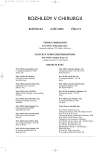Benefits of the Computer Navigation for Reconstruction of the Anterior Crutiate Ligament of the Knee Joint
Přínos počítačové navigace pro rekonstrukci předního zkříženého vazu kolenního kloubu
Cíl práce:
Cílem předkládané práce je radiologické hodnocení přesnosti umístění kostních kanálů u prvních rekonstrukcí předního zkříženého vazu (PZV) provedených s užitím navigačního systému.
Metodika:
Po artroskopické přípravě kloubního prostoru a registraci potřebných dat se cílí vodící dráty pro vrtání kanálů ve femuru a tibii pomocí navigačního systému. Štěp z lig. patellae je po té protažen a fixován interferenčními šrouby. Poloha kanálů byla hodnocena radiologicky metodami podle Bernarda-Hertela a Harnera.
Výsledky:
Korektní vyústění femorálního kanálu bylo nalezeno ve 13 (87 %) a tibiálního kanálu ve 14 (93 %) případech. Ideální poloha štěpu s ohledem na oba kostěné kanály byla zjištěna u 12 kolen (80 %).
Závěry:
Přesné cílení kostních kanálů je rozhodující pro dobrý výsledek rekonstrukce PZV. To je možné u standardních postupů jen v případě, že operatér provádí velký počet rekonstrukcí ročně. Ve skutečnosti je 70 % rekonstrukcí prováděno méně zkušenými ortopedy. První výsledky naznačují, že by navigační systém mohl být účinným pomocníkem operatérům, kteří nemají příležitost provádět tyto výkony příliš často.
Klíčová slova:
přední zkřížený vaz – počítačový navigační systém – rekonstrukce předního zkříženého vazu
Authors:
R. Hart; J. Krejzla; P. Šváb
Authors‘ workplace:
Ortopedické oddělení, Nemocnice Znojmo, prim. doc. MUDr. R. Hart, Ph. D.
Published in:
Rozhl. Chir., 2005, roč. 84, č. 9, s. 472-475.
Category:
Monothematic special - Original
Overview
Aim:
The aim of this work is a radiological assessment of accuracy of the osseous channels location in initial reconstructions of the anterior crutiate ligament (PZV) conducted using a navigation system.
Methodology:
Following arthroscopic preparation of the joint space and registration of the essential data, conducting wires for channels in tibia and femur are navigated using the navigation system. The lig. patellae graft is then pulled-through and fixed using interference screws. The channels location was assessed using radiological methods according to Bernard-Hertel and Harner.
Results:
A correct emergence of the femoral channel was found in 13 (87%) and of the tibial channel in 14 (93%) cases. The optimum graft location with respect to the both osseous channels was detected in 12 knee joints (80%).
Conclusions:
Exact location of the osseous channels is a principal prerequisite for a good result of the anterior crutiate ligament reconstruction. In case of standard procedures, this may be possible only in case the operating surgeon conducts a large number of reconstructions every year. In daily practice, however, 70% of reconstructions are conducted by less experienced orthopaedic surgeons. Our initial results indicate that the navigation system could become an effective tool for the surgeons who do not have the opportunity for conducting the above procedures too often.
Key words:
anterior cruciate ligament – computer navigation system – reconstruction of the anterior cruciate ligament
Labels
Surgery Orthopaedics Trauma surgeryArticle was published in
Perspectives in Surgery

2005 Issue 9
- Metamizole in perioperative treatment in children under 14 years – results of a questionnaire survey from practice
- Metamizole vs. Tramadol in Postoperative Analgesia
- Safety and Tolerance of Metamizole in Postoperative Analgesia in Children
Most read in this issue
- Comments on Eversion Technique of Carotid Endarterectomy
- The Liver Splenosis in a Patient Following a Procedure for the Malignant Seminoma
- Duodenal Stump Closure – Still a Live Problem. A Case Report
- A Contemporary Situation in the Antimicrobial Treatment of the Secondary Peritonitis
